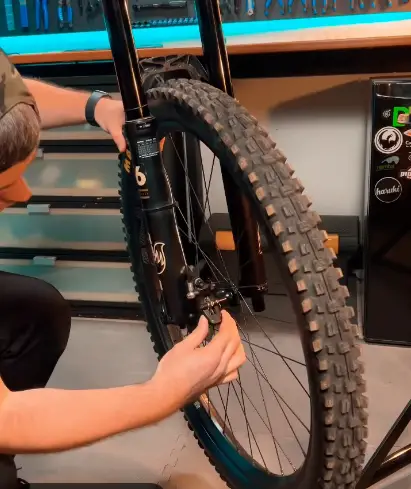MTB brake caliper alignment is crucial to your final braking performance and safe riding on any trail. Properly aligned brake calipers prevent such issues as one-sided braking, pad wear, and rotor rubbing, all which sully your cycling experience. Knowing how to align MTB brake calipers yourself can save you time and money while keeping your bike in top condition.
In this tutorial, we’ll guide you through the step-by-step procedure for adjusting your MTB brake calipers, so you’re equipped with the expertise to maintain your brakes in top working order, responsive on every ride. Let’s get aligned with the process!
1. Why Proper Brake Caliper Alignment Is Important
Proper alignment of your MTB brake calipers is paramount in offering smooth and consistent braking performance. Well-aligned calipers impart a uniform braking force, improving your control and safety when riding over technical terrain. Poorly aligned calipers lead to uneven wear of the brake pads and make your bike want to pull in one direction during braking, reducing overall braking performance.
Also, misaligned calipers create rotor rubbing, which not only damages your rotor but also makes pedaling smoother. Essentially, having your brake calipers aligned keeps you safe, saves you money on repair, and gives you better control of your rides.
2. Tools You’ll Need to Align MTB Brake Calipers
To successfully align your MTB brake calipers, you’ll need a few basic tools. Start by grabbing a 5mm Allen wrench, which is essential for loosening and tightening the brake caliper bolts. A screwdriver will also come in handy for any minor adjustments to the caliper or rotor.
Depending upon your brake configuration, you may need to have a brake pad spacer, which stops the brake pads from moving once you set the caliper in place. Having these simple tools ready, you will be equipped to perform the caliper alignment process and attain optimal brake performance for your MTB.
3. Step-by-Step Guide to Aligning MTB Brake Calipers
3.1. Check the Condition of the Brake Pads
Before adjusting your brake calipers, take a second to inspect the brake pads for any external indication of wear or damage. Brake pads do eventually wear out, which will then make them sit off-centered on the rotor. If they are worn, replace them before caliper alignment. Worn pads will not sit square and could lead to mediocre braking.
By swapping them in advance, you’ll have even-spaced calipers and the highest possible efficiency from your braking system.
3.2. Loosen brake caliper bolts
Then loosen the brake caliper bolts. Loosen the bolts that secure the caliper to the frame or fork using a 5mm Allen wrench. Loosening the bolts allows the caliper to move freely, which is crucial in centering the caliper over the rotor.
Only loosen the bolts to allow for adjustment; do not remove them completely at this point. As you do this, it is critical to keep the caliper stable and avoid excessive movement as you proceed with the alignment.
3.3. Center the Brake Caliper
Now that the bolts on the caliper are loose, center the brake caliper above the rotor. Position the caliper flat on both sides of the rotor. The brake pad to rotor clearance should be equal on both sides of the caliper. This is crucial for achieving even braking performance. If one of the sides of the caliper is near the rotor, while the other is not, it will lead to uneven brake pad wear and poor braking. Be patient at this stage so that the caliper is central.
3.4. Caliper Adjustment for Correct Rotor Clearance
After centering the caliper, ensure the rotor clearance. The brake pads need to leave a small but fixed gap from the rotor to ensure effective braking without creating friction. If they are closer to the rotor, they will touch the rotor and create drag and energy loss.
If they are too far, braking performance will be lost. Balance the caliper such that the clearance is accurately right, and take care not to have the pads touch the rotor when the brake is off. A spacer for the brake pads will be useful to keep the pads in their proper position during this.
3.5. Tightening Caliper Bolts
With the caliper having been centered and its clearance from the rotor accurately set, it is now time to tighten the caliper bolts. Use your 5mm Allen wrench to tighten the bolts securely, without over-tightening them, which might strip threads.
Tightening the bolts will make the caliper stay in its correct place. Check the alignment of the caliper once more by revolving the wheel to make sure there’s no rubbing against the rotor. A test ride will also quickly verify that brakes are working smoothly and consistently.
4. Check the Brakes
Once you have aligned your brake calipers, check the braking system to determine if everything is working as it should be. Grab the brake lever firmly and listen for any unusual sound, such as rubbing or squealing. You want to have smooth and consistent braking. If you notice rubbing sounds, it indicates that the caliper can still be out of alignment or the rotor could be warped.
In these situations, make slight modifications to the rotor or caliper until the sound is eliminated. A test ride on a test track will assist you in further analyzing the performance and making any final adjustments.
5. Watch Out for These Common Missteps in Aligning MTB Brake Calipers
Even though it is a straightforward process, aligning your MTB brake calipers can have several common missteps that must be avoided.
- One of the most frequent missteps is to incorrectly align the caliper while tightening and thereby cause uneven braking or rotor rub. Double-check alignment prior to tightening bolts to avoid this.
- The second is not inspecting the brake pads for damage or wear prior to an alignment. When they are worn out or damaged, this may result in a reduction in braking performance.
- Lastly, neglecting to check rotor clearance can result in high brake drag, which is inefficient and wastes energy. Avoid these mistakes to ensure a successful alignment.
FAQ’s
How do I check whether my brake calipers are properly aligned?
Check the spacing of the brake pad and rotor. The caliper should be centrally positioned, equally spaced from both sides of the rotor. Squealing noises while riding are a sign that the caliper may require adjustment.
Can I align MTB brake calipers myself?
Yes, you may self-align your MTB brake calipers using a simple tool like an Allen wrench and screwdriver. Follow the step-by-step guide to align correctly.
How often should I align my MTB brake calipers?
It’s advised to check and align your brake calipers every few months or after intense use, especially if you’ve undergone a change in braking performance.
What can I do if my MTB brake calipers continue not to work after aligning?
If alignment fails to resolve the issue, check for other problems like worn-out brake pads, a warped rotor, or air in the brake lines. Sometimes you will have to bleed your brakes or replace components.
6. Correct Brake Caliper Alignment
Brake caliper alignment can shift over time, especially after rough rides or changes in terrain. It’s important to regularly check the alignment to ensure continued braking performance. After each ride, inspect the calipers for any signs of misalignment, especially if you’ve encountered obstacles or rough terrain.
Over time, the brake pads may wear down, causing the caliper to shift slightly. Regularly adjusting and maintaining your brake caliper alignment will keep your brakes working optimally and prevent premature wear on both the calipers and the rotor, ensuring a smooth and safe ride.
Conclusion
Synchronizing your MTB brake calipers is essential for efficient braking performance, safety, and seamless trail riding. The process involves inspecting brake pads, loosening caliper bolts, centering the caliper, adjusting rotor clearance, and tightening the bolts using a tightening action.
Caring for it is important inspect and tweak the calipers at regular intervals to deliver consistent performance and avoid wear. Proper alignment not only improves brake function but also prolongs the lifespan of your components. By maintaining properly aligned calipers, you’ll enjoy a safer, more enjoyable cycling experience with every ride.

I am Ryan Ford, a mountain biking enthusiast who loves to explore the outdoors. I also like to go on adventures with friends and anything else that involves being outside. I love my bike because it gets me out of the house and gives me an opportunity to enjoy nature.

